Philippines: nationwide house prices rising strongly, but Metro Manila’s CBD is slowing
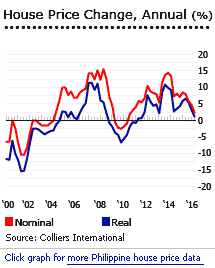 The Philippines´ residential property market has performed spectacularly, due to robust economic growth. During the year to Q1 2016, the nationwide residential real estate price index rose by 9.2% (8% inflation-adjusted), according to the Bangko Sentral ng Pilipinas (BSP), the country’s central bank.
The Philippines´ residential property market has performed spectacularly, due to robust economic growth. During the year to Q1 2016, the nationwide residential real estate price index rose by 9.2% (8% inflation-adjusted), according to the Bangko Sentral ng Pilipinas (BSP), the country’s central bank.
Quarter-on-quarter, the index rose 1.9% (1.9% inflation-adjusted) in Q1 2016. The residential real estate price index, published every quarter, is based on bank reports on residential real estate loans.
By property type:
- Condominium units saw y-o-y price increase of 12.9% (11.6% inflation-adjusted) in Q1 2016
- For single detached/attached house prices rose by 8.1% (6.9% inflation-adjusted) y-o-y in Q1 2016
- For duplex house prices rose by 6.7% (5.5% inflation-adjusted) y-o-y in Q1 2016
- Townhouse prices rose by 8.5% (7.3% inflation-adjusted) over the same period
In the National Capital Region (NCR), residential property prices surged 9.7% (8.5% inflation-adjusted) during the year to Q1 2016 while in Areas Outside the NCR (AONCR), prices rose by 9.4% (8.2% inflation-adjusted), according to the BSP.
On the other hand, prices of high-end condominium units in Metro Manila’s CBDs rose at a much slower pace. The average price of a luxury 3-bedroom condominium unit in Makati central business district (CBD) rose by a modest 2.4% (1.23% inflation-adjusted) during the year to Q1 2016 to PHP151,622 (US$3,203) per square metre (sq. m.), according to Colliers International - the lowest y-o-y increase in Makati CBD since Q3 2010. During the latest quarter, condominium prices increased 0.2% (0.2% inflation-adjusted) in Q1 2016.
Price rises also slowed in other major Metro Manila CBDs:
- In Rockwell Center, the average price for a 3-bedroom condominium rose by 5.5% (4.3% inflation-adjusted) to PHP162,500 (US$3,433) per sq.m., or a 0.2% q-o-q growth.
- In Fort Bonifacio, the average price for a 3-bedroom condominium increased by 2.6% (1.4% inflation-adjusted) to PHP150,000 (US$3,169) per sq. m., or a 2.6% q-o-q rise.
Nationwide residential property prices are expected to continue to rise strongly for the remainder of the year, boosted by robust economic growth. On the other hand, Metro Manila’s CBDs are expected to slow due to a demand /supply mismatch.
| AVERAGE PRICE FOR A 3-BR CONDOMINIUM | |||||
| Q1 2015 | Q1 2016 | y-o-y change | |||
| Location | PHP per sq. m. | USD per sq. m. | PHP per sq. m. | USD per sq. m. | % |
| Makati CBD | 102,500 - 192,200 | 2,166 – 4,061 | 106,600 - 196,600 | 2.4 | |
| Ortigas Center | 119,000 - 189,000 | 121,700 - 202,100 | 5.5 | ||
| Fort Bonifacio | 113,000 - 179,500 | 114,700 - 185,400 | 2.6 | ||
| Source: Colliers International | |||||
The Philippine economy grew by 6.9% in Q1 2016 from a year earlier, up from growth of 6.5% in Q4 2015, 6% in Q3 2015, 5.8% in Q2 2015, and 5% in Q1 2015, according to the Philippine Statistics Authority (PSA). The economy is projected to grow by 6% in 2016, and 6.2% in 2017, according to the International Monetary Fund (IMF).
Can President Duterte match the successes of the Aquino administration?

Former president Benigno (Noynoy) Aquino III (president June 2010 - June 2016) instituted a no-holds barred anti-corruption campaign which wowed foreign investors and caused consumer confidence to surge. The Philippines is now one of the fastest growing economies in Asia, with an average growth rate of 6.4% during the past four years, according to the IMF.
The Philippines’ investment ratings were upgraded to investment grade by Moody, Standard & Poor’s, and Fitch Ratings. The country now ranks 47th out of 140 economies in the Global Competitiveness Index (2015-2016), up from 52 in 2014, 59 in 2013, and 65 in 2012.
Rising investment, plus low interest rates, increased condominium prices by 48.9% (26.5% inflation-adjusted) between Q3 2010 and Q4 2015. Property prices have risen as much as 114.9% (38.5% in real terms) from 2004 to 2015.
Will this success continue? During the May 2016 presidential election, former Davao City mayor Rodrigo Duterte won a landslide victory, capitalizing on discontent with rising inequality and on the perceived incompetence of Aquino´s chosen successor, Mar Roxas. Duterte vowed to bring progress to all Filipinos, to eliminate government corruption and to substantially reduce crimes, especially the use of illegal drugs. While in his former job he was strongly suspected of running death squads to accomplish this goal, Duterte´s hands-on work ethic made Davao an efficiently run city.
Duterte is a somewhat incoherent speaker, saying contradictory things at different times. Some of his appointments as president have not matched his clean government rhetoric. The Philippine one-term presidential system reposes enormous power in the hands of the president, and a repeat of the disastrous experiences under presidents Joseph Estrada (1998-2001) or Gloria Macapagal-Arroyo (2001-2010) could reverse many gains made by the outgoing administration.
Yet for now, most Filipinos give Duterte the benefit of the doubt.
Philippine residential property is still below pre-Asian Crisis values!
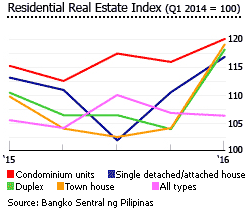
Surprisingly, despite so much price appreciation, the Philippine housing market has still not recovered from the crash after the 1997 Asian Financial Crisis. Between 1997 and 2004, luxury condominium prices dropped 30.4% (53.7% in real terms), in the biggest property crash of all countries affected by the Asian Financial Crisis.
In current price terms, both rental rates and property values are back above 1997 levels. However residential property prices in Q1 2016 are still 30.5% below pre-Asian Financial Crisis levels in real, inflation-adjusted terms.
Land values continue to appreciate
Land prices continue to rise in all major areas:
- In Makati CBD, the average land value increased 4.59% to PHP523,000 (US$11,050) per sq. m. in Q1 2016 from the previous quarter, according to Colliers International.
- In Fort Bonifacio, land prices rose by 6.7% to an average of PHP445,000 (US$9,402) per sq. m. in Q1 2016 from the previous quarter.
- In Ortigas Center, land values rose by 5.3% to an average of PHP189,000 (US$3,993) per sq. m. over the same period.
- In Alabang, land prices rose by 4.6% q-o-q to an average of PHP123,000 (US$2,599) per sq. m. in Q1 2016.
Land prices are projected to continue rising in the medium term.
| LAND VALUES, Q1 2016 | ||||
| Land prices | q-o-q change | y-o-y change | ||
| Location | PHP per sq. m. | USD per sq. m. | % | % |
| Makati CBD | 378,000 – 668,000 | 7,986 – 14,114 | 4.59 | 15.4 – 19.3 |
| Fort Bonifacio | 315,000 – 575,000 | 6,655 – 12,149 | 6.70 | 15.0 – 15.4 |
| Ortigas Center | 141,000 – 237,000 | 2,979 – 5,007 | 5.25 | 12.8 – 19.7 |
| Source: Colliers International | ||||
Residential licenses to sell surging
Residential licenses to sell surged 77% to 85,470 in Q1 2016 from the same period last year, based on figures from the Housing and Land Use Regulatory Board (HLURB).
During the first quarter of 2016 (based on the report released by Colliers International):
- For open market housing, new licenses more than tripled to 11,904 units from a year earlier.
- For mid- and high-end condominium units, new licenses to sell rose 18% y-o-y to 12,805 units.
- For low-cost condominium units, new licenses to sell rose 181% to 1,365 units from a year ago.
- For mid-income housing, new licenses almost doubled to 1,566 units from a year ago.
- For social housing, new licenses soared by 81% y-o-y to 6,816 units.
- For commercial subdivisions, new licenses surged 124% y-o-y to 141 units.
Housing supply continues to rise
In the five major districts in Metro Manila, three residential projects were completed in the first quarter of 2016 – all in Fort Bonifacio: The Venice Luxury Residence-Carusso Tower (330 units), The Venice Luxury Residences-Dominico Tower (330 units), and Viceroy McKinley Hill (320 units).
For the rest of 2016, around 11,700 units are expected to be delivered in Metro Manila’s five major CBDs, according to Colliers. Half the new supply will be in Fort Bonifacio, 30% in Makati CBD and the remaining 20% in Rockwell, Ortigas, and Eastwood.
Among the residential projects expected to be completed in coming months include:
- One Eastwood Avenue Tower 1 (Eastwood City)
- Arya Residences Tower 2 (Fort Bonifacio)
- Avida Towers BGC 34th Street Tower 1 (Fort Bonifacio)
- Viceroy McKinley Hill Tower 2 (Fort Bonifacio)
- The Lerato Tower 2 (Makati)
- Alphaland Makati Place (Makati)
- Eton Tower (Makati)
- The Sonata Premier Residences (Ortigas)
- Avant Garde Residences (Ortigas)
| RESIDENTIAL SUPPLY | ||||
| Residential Stock | Forecast New Supply | |||
| Location | 2015 | 2016F | 2017F | 2018F |
| Makati CBD | 19,337 | 3,660 | 3,450 | 1,072 |
| Rockwell | 4,159 | - | 346 | 492 |
| Fort Bonifacio | 22,206 | 6,730 | 4,125 | 3,129 |
| Ortigas | 16,250 | 1,355 | 899 | 422 |
| Eastwood | 7,548 | 988 | - | 632 |
| Total | 69,500 | 12,733 | 8,820 | 5,747 |
| Source: Colliers International | ||||
Interest rates kept steady; mortgage market remains small

Housing loan rates charged by major commercial banks range from 5.3% to 7.8% for one-year fixed loans, and from 7% to 10% for five-year fixed mortgages. The BSP has kept its policy rate at 3% for overnight borrowing; overnight lending and repurchase facility (RF) and deposit facility at 3.5% and 2.5%, respectively. The reserve requirement ratios were steady at 20%.
Severe problems impede mortgage market growth. Few major banks offer housing loans. And although loan-to-value ratios of 90% are now in theory being offered and loan tenors can be as long as 30 years, in fact most loans are short-term. Banks are wary because land titling and registration problems are prevalent, as are lengthy delays in the foreclosure process due to the country´s very weak court system. Therefore approval of loan applications takes a long time. In addition inter-bank collusion prevails: different banks’ loans have strangely similar terms and conditions.
Property buyers also face high transaction costs, corruption and red tape, fake land titles and substandard building practices. Plus, the large informal housing sector and their incentives make it less attractive for low to middle income families to buy or rent properties.
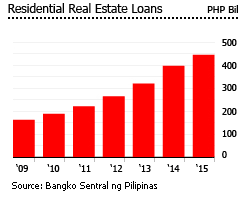
Because of these factors, the ratio of residential mortgage loans to GDP remains small, at around 3.36% of GDP in 2015, a slight increase from 2.03% of GDP in 2009. Most houses in the Philippines are sold for cash or pre-sold, with the developers offering financing.
In March 2016, the total outstanding residential real estate loans increased 11.9% to PHP462.4 billion (US$9.77 billion) from the same period last year, based on figures from the BSP.
Residential rents soften, vacancy rates up
Residential rents across CBDs (with an exception of Ortigas) are now softening, amidst stable residential supply and low absorption rates.
In the first quarter of 2016:
- In Makati CBD, monthly residential rents fell by 1.6% q-o-q to an average of PHP869 (US$18.36) per sq. m.
- In Fort Bonifacio, monthly residential rents dropped 2% q-o-q to PHP873 (US$18.44) per sq. m.
- In Rockwell, monthly residential rents dropped 0.5% q-o-q to an average of PHP958 (US$20.24) per sq. m.
- In Ortigas Center, monthly residential rents rose by 2% q-o-q to PHP516 (US$10.9) per sq. m.
Rents in these locations are projected to drop further by 2% to 3.2% in the next 12 months, according to Colliers.
In Makati CBD, residential vacancy rates across all grades increased to 9.58% in Q1 2016 from 8.93% in the previous quarter and 7.9% a year earlier, as take-up slowed due to the substantial additional supply in neighboring areas, based on figures from Colliers.
- For the luxury segment, the vacancy rate stood at 8.33% in Q1 2016, significantly up from 5.95% in the previous quarter and 4.3% in Q1 2015
- For the other segments, the vacancy rate rose to 9.76% in Q1 2016, from 9.36% in the previous quarter and 8.66% in a year earlier.
The residential condo rental market in the rest of the country’s major CBDs recorded varying results.
- In Rockwell Center, the vacancy rate increased to 3.9% in Q1 2016 from 3.4% in the previous quarter
- In Fort Bonifacio, the vacancy rate was stable at around 8.6% in Q1 2016
- In Ortigas Center, the vacancy rate improved to 8.5% in Q1 2016 from 10.4% in the previous quarter
| RESIDENTIAL LEASE RATES, Q1 2016 | |||||
| Minimum monthly rent | Maximum monthly rent | ||||
| Location | Type | PHP | USD | PHP | USD |
| Forbes Park | Exclusive village | 250,000 | 5,282 | 650,000 | 13,733 |
| Dasmarinas Village | Exclusive village | 230,000 | 4,859 | 600,000 | 12,677 |
| Urdaneta Village | Exclusive village | 250,000 | 5,282 | 360,000 | 7,606 |
| Bel-Air Village | Exclusive village | 230,000 | 4,859 | 350,000 | 7,395 |
| San Lorenzo Village | Exclusive village | 140,000 | 2,958 | 250,000 | 5,282 |
| Magallanes Village | Exclusive village | 150,000 | 3,169 | 250,000 | 5,282 |
| Ayala Alabang Village | Exclusive village | 130,000 | 2,747 | 280,000 | 5,916 |
| Apartment Ridge/Roxas Triangle | High-rise condo | 150,000 | 3,169 | 300,000 | 6,338 |
| Salcedo Village | High-rise condo | 100,000 | 2,113 | 260,000 | 5,493 |
| Legaspi Village | High-rise condo | 130,000 | 2,747 | 250,000 | 5,282 |
| Rockwell | High-rise condo | 140,000 | 2,958 | 250,000 | 5,282 |
| Fort Bonifacio | High-rise condo | 120,000 | 2,535 | 260,000 | 5,493 |
| Source: Colliers International | |||||
Gross rental yields remain high, but beware of taxes
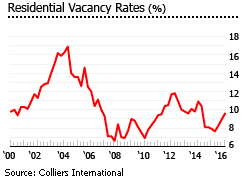
According to research by the Global Property Guide, gross rental yields in Metro Manila remain good, ranging from 7.04% on the very smallest condominium units of 30 sq. m. to 7.72% on 80 sq. m. condominiums.
These yields are before taxes and other expenses. They are for the high-end areas: Makati CBD, Ortigas CBD, Rockwell, The Fort, and Eastwood City.
This does not mean that foreign investors should necessarily rush to invest in Manila, because transaction taxes (known as ‘capital gains taxes’, but not actually such), and (if observed) official income tax rates applicable to non-resident investors, are high.
Manila’s segmented market
Lower down the income scale there is cause to worry.
There are three identifiable segments in Manila’s housing market:
- The high end. Local high-earners and expatriates occupy this segment.
- The middle tier. The mid-end condominium sector, with monthly amortization of around PHP10,500 (US$222), presently requiring a dispensable income greater than PHP34,962 (US$739), to obtain a housing loan of PHP2 million (US$42,256). This segment has been targeted by many developers, and is attractive to overseas foreign workers (OFWs).
- The low end. This is where the mass of the population live.
We believe that the middle tier is over-supplied. Many of these lower middle-class condominium developments are ghost cities.
Manila’s ghost cities
A visit to any ‘Barrio Fiesta’ in any city where Philippine OFWs work abroad is dominated by condominium offerings from developers like Megaworld, DMCI, Ayala Land, etc. The Philippines is one of the world’s largest remittance recipients, with 10.5 million Philippine Overseas Foreign Workers (OFWs) living and working in 210 countries and territories worldwide, 47% of them permanent migrants, 40% temporary, and the rest "irregular migrants". Among the permanent overseas Filipinos, 65.2% live in the US, followed by Canada (13.1%), Europe (7.1%), Australia (6.8%), and Japan (3.4%), according to the Commission on Filipinos Overseas (CFO). In 2015, total cash remittances reached a record high of US$25.8 billion (or about 8.83% of GDP), up by 4.62% from a year earlier. In the first four months of 2016, cash remittances rose by 3.1% y-o-y to US$8.67 billion.
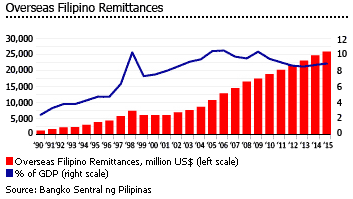
It is estimated that 60% of these remittances go directly or indirectly to the real estate sector, according to the World Bank. These OFW remittances power the low-end to mid-range residential property market, housing projects and mid-scale subdivisions in regions near Metro Manila, such as Cavite, Batangas, and Laguna Provinces.
According to the Philippine Housing and Land Use Regulatory Board, 452,198 condominium units were built in Metro Manila from January 2001 to March 2014. Then last year, around 32,700 residential condominium units were launched in the metropolis. There are around 807,496 families or 27.5% of the NCR population who have a dispensable income greater than PHP34,962 (US$783), which is the required monthly income to be able to afford the monthly amortization of PHP 10,500 (US$235). PHP10,500 (US$235) is the minimum monthly amortization for a housing loan of PHP2 million (US$44,801), with accommodating loan rates of 90% LTV, with an annual interest rate of 5.7%, and a loan tenor of 30 years.
So for all these newly-built condominiums to be occupied by those who could afford to rent or buy (we calculate for the buying case, but given current interest rates it may be more expensive to rent), 56% of locals who have the financial capacity to occupy them would need to do so, i.e., 56% of the 807,496 families with the financial capacity to do so, should purchase or rent a unit, for the available supply of condominium units to be taken up.
These are problematic numbers given that many of these families already have houses in the first place. The World Bank assumes only 10% of these capable end-users as prospective end-users, indicating a gross oversupply.
In terms of affordability, property developers are building more mid-end condominium units than locally-based Filipinos can afford to occupy. Many of the buyers are OFWs, causing a mismatch between demand and supply.
Average annual growth of remittances was only 6.7% from 2009 to 2015, compared to 15.5% annually from 2002 to 2009. The World Bank believes the slowdown in remittances is due to:
- Stricter Implementation of the migrant workers’ bill of rights;
- Political uncertainties in host countries; and
- The slowdown in the advanced economies.
A puzzle – why are call-centre workers under-housed
The Philippines has a thriving business process outsourcing (BPO) sector. The BPO industry is now one of the country’s biggest sources of revenues, providing employment to a large number of workers.
In 2015, revenues from the BPO industry reached US$22 billion, up from US$18.9 billion in the previous year. In terms of job generation, the industry accounted for around 1.1 million direct employees in 2015, up from 1.03 million employees a year earlier.
The BPO industry aims to add around 225,000 new jobs and to reach US$25 billion in revenues this year, according to the Department of Labor and Employment (DOLE).
The BPO industry was mainly driven by the healthcare sector that accounted for around 100,ooo employees, and the BPOs in so-called “Next Wave Cities”, according to Danilo Sebastian Reyes, the chairman of the IT & Business Process Association of the Philippines. The 10 “Next Wave Cities” include Baguio City, Davao City, Dumaguete, Iloilo, Lipa, Metro Bulacan, Metro Cavite, Metro Laguna, Metro Naga, and Metro Rizal.
BPO agents are likely to wish to rent residential spaces near their workplaces due to their night shift schedules. Since BPO agents have foreign countries as their clientele, their work hours follow suit. This means that most BPO employees work at the night time where commuting is risky while taxi cab fares are expensive.
There is a puzzle here. The income of this rising demographic overlaps with the investments made by the OFWs. Many call-centre agents are in the targeted income-bracket. But anecdotal evidence suggests that many of condominiums bought by OFWs are in the wrong place for call-centre agents.
In any case, the bottom line is that their spending-power is not yet strong enough to absorb supply. Many have family obligations and prefer to live at home or with relatives.
Maybe this will change. The Philippines will also soon experience a demographic ‘sweet spot’. The country has the third youngest population in the ASEAN region, next only to Lao PDR (median age of 21 years) and Cambodia (median age of 22 years). Based on its demographic profile, we can expect a strong demand for starter homes.
“Affordable” housing
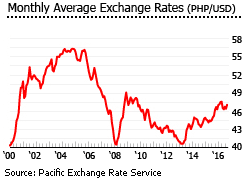
The Philippines has a huge housing need at the low end. There are as much as 300,000 households in Metro Manila residing in informal and uninhabitable housing units which composes 8.7% of the total Metro Manila population. These people live in appalling conditions. Many others live in very poor conditions.
To meet the needs of these families, the government embarked on the National Shelter Program to provide housing for informal settlers and other families who do not have enough income to rent nor buy houses in the prevailing markets rates.
Socialized housing units, or those which cost less than PHP450,000 (US$10,800) can be purchased with a monthly amortization of PHP2,302 (US$56). The Pag-Ibig Fund, (which is the Filipino word for love), the country’s state-owned and subsidized housing loan provider, provides a fixed rate of 4.5% for 30 years for socialized housing units.
The problem is that these low-end housing units are usually far from work.
Recently, VP Leni Robredo, who is known for her anti-poverty advocacies, was appointed to head the Housing and Urban Development Coordinating Council (HUDCC). Following the appointment, Robredo vowed to improve the quality of life of poor Filipinos. The HUDCC is the highest policy-making body for housing and is in charge of implementing the National Shelter Program.
Robust economic growth
The Philippine economy grew by 6.9% in Q1 2016 from a year earlier, the fastest among major Asian economies and up from GDP growth rates of 6.5% in Q4 2015, 6% in Q3 2015, 5.8% in Q2 2015, and 5% in Q1 2015, based on figures from the National Economic and Development Authority (NEDA). The strong growth was investment-driven on the demand side, with significant contribution from investments in durable equipment.
During Q1 2015:
- Fixed capital investment grew 25.5% and contributed 5.8 percentage points to real GDP growth
- Construction grew 12%, up from growth rates of 7.6% in the previous quarter and 4.5% in a year earlier. In fact, public construction expanded by 39.9%, in sharp contrast with a 23% decline a year earlier
- Exports rose by 6.6% while imports grew by 15.9%
In addition, election-related spending buoyed domestic demand through May 2016, when the national and subnational elections were held.
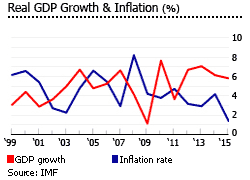
“All these investments give us confidence that the economy will continue to perform well in the succeeding quarters of the year and beyond,” said former NEDA chief Emmanuel Esguerra.
The economy is projected to grow by 6% in 2016 and another 6.2% in 2017, according to the IMF, from GDP growth rates of 5.8% in 2015, 6.1% in 2014, 7% in 2013, and 6.7% in 2012.
In Q1 2016, the nationwide unemployment rate stood at 5.8%, up from 5.7% in the previous quarter but down from 6.6% a year earlier, according to the Bangko Sentral ng Pilipinas (BSP). Unemployment is expected to fall to 6% in 2016 and to 5.8% in 2017, from an annual average of 7.2% from 2006 to 2015, according to the IMF.
In June 2016, the country’s inflation rate was 1.9%, up from 1.6% in the previous month and 1.2% in the same period last year, according to the Philippine Statistics Authority (PSA). The rising inflation was mainly due to the slight recovery in oil prices and the lingering effects of El Niño weather conditions in the country. Inflation is expected at 2% this year, according to the IMF. Inflation started to slow sharply in 2015 to 1.4%, from 4.2% in 2014, 2.9% in 2013, 3.2% in 2012, 4.7% in 2011, and 3.8% in 2010.
The Philippine peso is expected to depreciate to US$1 to PHP49 by end-2016, mainly due to continued external volatility related to Brexit and the weak Chinese yuan, according to BMI Research. Currently, the exchange rate stand at US$1 = PHP47.35, about 8.2% depreciation from a year earlier.
Duterte’s 10-point socio-economic agenda
Days after officially taking office, the new administration unveiled its 10-point socio-economic agenda.
- Current macroeconomic policies
- Tax reform
- Competitiveness and ease of doing business
- Infrastructure spending
- Rural and value chain development
- Security of land tenure
- Human capital development
- Science, technology, and creative arts
- Social protection programs
- Responsible Parenthood and Reproductive Health Law
“Contracts will be respected. Good governance will be delivered. Corporate taxes will be lowered. Infrastructure will be built and the ease of doing business will be improved,” said newly appointed Finance Secretary Sonny Dominguez.
Just recently, the Asian Development Bank (ADB) commended the Duterte administration and offered greater financial assistance to show strong support to the new administration’s 10-point agenda.
“The recent strong growth of the Philippines provides a foundation for further sustainable growth to fully realize this country’s enormous potential,” said ADB President Takehiko Nakao. “Our support will be tailored to the government’s socio-economic and poverty reduction priorities, and to the country’s middle-income status. We are looking forward to further discussions on how we can best support the country,” Nakao added.